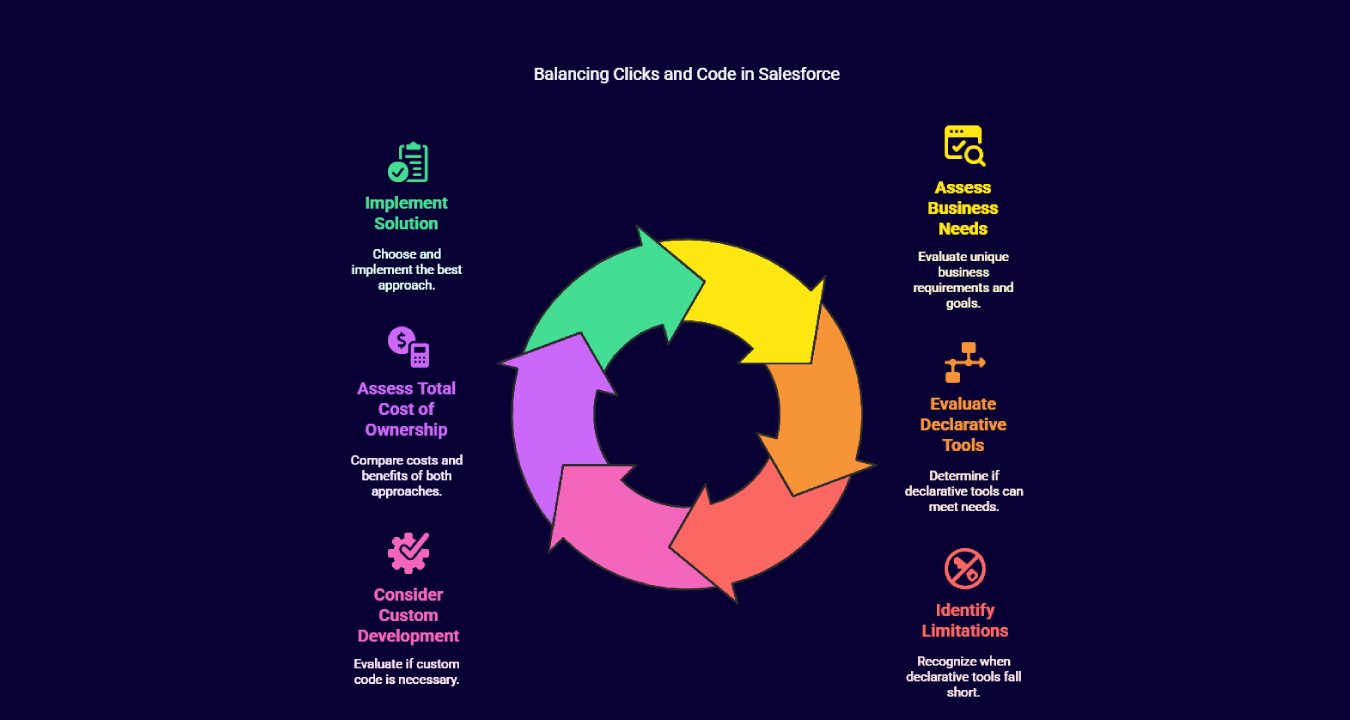
The Salesforce ecosystem thrives on the powerful promise of “clicks not code.” It’s an empowering mantra, suggesting rapid development, lower costs, and accessibility for administrators and citizen developers alike. For many scenarios, declarative tools – Process Builder, Flow, Lightning App Builder – are indeed the fastest, most efficient path to delivering business value. They democratize innovation and accelerate time-to-market.
At Xccelerance Technologies, we champion these tools daily. They form the backbone of agile, responsive Salesforce solutions. But we also recognize a crucial inflection point where the relentless pursuit of “clicks not code” can lead to solutions that are convoluted, difficult to maintain, and ultimately, more costly in the long run. The savvy leader knows that a mantra, however useful, should never become dogma.
So, when does the pendulum swing? When does investing in custom development (think Apex, Lightning Web Components, custom integrations) become not just an option, but the smarter strategic investment for your Salesforce platform?
Beyond the Basics: Where Clicks Hit Their Ceiling
While declarative tools are incredibly versatile, their limits become apparent when faced with certain business imperatives:
- Uniquely Differentiating Business Processes:
Your competitive edge often lies in processes that are uniquely yours – the secret sauce that sets you apart. While you can often approximate these with clicks, forcing a highly specific, nuanced process into a declarative framework can result in a clunky, inefficient workaround. Custom code can precisely model these bespoke workflows, ensuring your technology amplifies, rather than constrains, your unique value proposition. This isn’t just about functionality; it’s about encoding your distinct operational DNA into your core platform. - Complex Logic and High-Volume Transactions:
As business logic becomes increasingly intricate, involving multiple decision branches, sophisticated calculations, or real-time processing of large data volumes, declarative tools can struggle. You might find yourself building a “Rube Goldberg machine” of flows and processes that are hard to debug, harder to maintain, and can hit platform governor limits, impacting performance. Custom Apex code, when well-architected, handles complexity and scale with far greater elegance and efficiency, ensuring system stability and responsiveness even under duress. - Sophisticated User Experiences (UX) and User Interfaces (UI):
Standard Salesforce interfaces are functional, but your vision might demand a highly tailored, branded, or simplified user experience to drive adoption and productivity, especially for customer-facing portals or specialized internal roles. While Lightning App Builder offers considerable flexibility, achieving a truly bespoke and intuitive UI often necessitates Lightning Web Components (LWCs). Investing here isn’t just aesthetic; it’s about maximizing user engagement and minimizing friction, directly impacting ROI. - Deep, Bi-Directional Integrations with External Systems:
While AppExchange solutions and declarative integration tools cover many common scenarios, complex integrations – especially those requiring intricate data mapping, real-time synchronization, robust error handling, or communication with legacy or proprietary systems – often demand custom API development. A custom solution ensures data integrity, system resilience, and a seamless flow of information across your entire technology landscape, which is critical for a holistic view of your operations. - Long-Term Maintainability and Governance at Scale:
Ironically, an over-reliance on “clicks” for complex solutions can lead to what some call “declarative debt”. A sprawling web of interconnected flows and process builders can become opaque, making it challenging for new team members to understand, modify, or troubleshoot. Well-documented, modular custom code, managed with proper version control and development practices, can offer greater clarity and easier long-term governance for sophisticated functionalities, reducing the risk of future bottlenecks.
The Strategic Calculus: Total Cost of Ownership vs. Initial Outlay
The decision isn’t merely technical; it’s deeply strategic. While custom development often involves a higher upfront investment in terms of time and specialized talent, the calculus must extend to Total Cost of Ownership (TCO) and strategic enablement:
- Scalability: Will the “clicks” solution scale with your projected growth, or will you need to re-architect it in a year or two, incurring further costs and disruption?
- Adaptability: How easily can the solution adapt to evolving market conditions or business strategies? Sometimes, a custom framework offers more adaptable “levers.”
- Performance: Will the declarative approach degrade performance as data volumes or user loads increase, impacting productivity?
- Risk Mitigation: Does a complex declarative setup introduce hidden risks in terms of maintainability or stability?
The Xccelerance Perspective: A Pragmatic Partnership
At Xccelerance, we believe the “clicks not code” mantra is a valuable starting point, an ideal to strive for. But true platform mastery lies in understanding its boundaries and recognizing when a tailored, custom approach will deliver superior, sustainable value. It’s rarely an either/or proposition. Often, the most potent solutions blend the best of both worlds: leveraging declarative tools for speed and simplicity where appropriate, and strategically deploying custom code for power, precision, and differentiation.
The smartest Salesforce investment isn’t about dogmatically adhering to one approach. It’s about a clear-eyed assessment of your unique business needs, your long-term strategic goals, and the optimal path to achieving them. It’s about choosing the right tool for the right job, every time, ensuring your Salesforce platform is not just a CRM, but a dynamic engine for growth and innovation.


